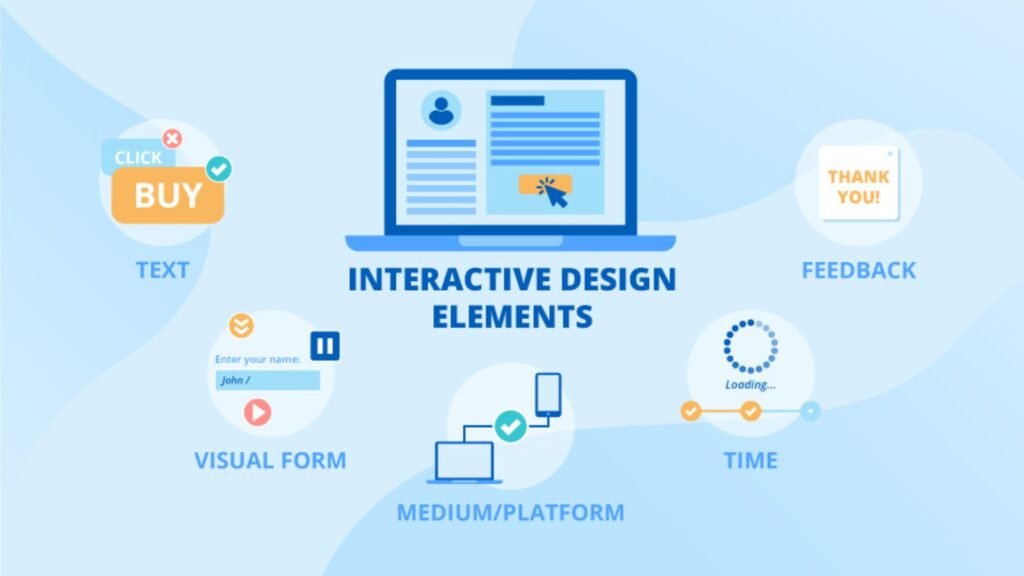Interactive Elements for Better UX
- By -Daisy
- Posted on
- Posted in Web Designing
In web design, interactivity is key to improving user experience (UX). Interactive elements like buttons, forms, animations, and hover effects can make websites feel more engaging and user-friendly. When implemented thoughtfully, these elements create a dynamic experience that encourages users to interact with the content, making them feel more connected to the website. In this article, we’ll explore various interactive elements you can use to boost UX, explain why they matter, and offer practical tips for effective implementation.

What are Interactive Elements?
Interactive elements are components on a webpage that allow users to take action and engage with content. These elements respond to user inputs, such as clicks, taps, or hover actions. They can range from simple buttons and forms to complex animations or interactive maps.
The goal of interactive elements is to enhance user engagement, simplify navigation, and make a website feel more responsive and dynamic. When used properly, interactive elements improve the overall usability of a site and encourage users to spend more time exploring its content.
Why Interactive Elements Matter for UX
Interactive elements play a significant role in improving user experience. Here’s why they matter:
1. User Engagement
Interactive elements keep users involved in the website experience. Instead of passively consuming content, users can interact, making the experience more memorable and enjoyable. Engaged users are more likely to return to the site and complete desired actions, such as signing up or making a purchase.
2. Clear Communication
Interactive elements can simplify complex tasks or instructions. For instance, a well-designed form with intuitive input fields or a progress bar during a checkout process can make it easier for users to complete an action without confusion. They provide users with immediate feedback, improving the clarity of their interactions.
3. Improved Navigation
Interactive elements like clickable buttons, hover effects, and dropdown menus make navigation more intuitive and smooth. Clear, easy-to-find interactive elements guide users through the site, helping them find the content they need quickly.
high roller casinos at au.crazyvegas.com
Xenexbd.com appears to be a business website, possibly related to technology or services in Bangladesh. While professionals and clients engage with their offerings, some individuals with a taste for high-stakes entertainment might also enjoy online gaming. For those seeking exclusive online platforms, explore high roller casinos at au.crazyvegas.com. Discover VIP programs and high-limit gaming opportunities available.
4. Boosts Conversion Rates
Well-designed interactive elements can guide users toward completing conversions, whether that’s filling out a contact form, subscribing to a newsletter, or purchasing a product. A well-placed call-to-action (CTA) button or an easy-to-use form can make all the difference.
5. Visual Appeal
Interactive elements contribute to the overall visual aesthetics of a site. Dynamic interactions like animations and hover effects add excitement and can help reinforce branding, making the site feel modern and polished.
Key Interactive Elements to Enhance UX
1. Buttons
Buttons are among the most common interactive elements on a website. They serve as the primary way for users to take actions, such as submitting a form, navigating to another page, or adding an item to their cart.
- Design Tips: Make sure buttons are easily recognizable, with a clear call-to-action (CTA). Use contrasting colors and appropriate size so that users know where to click.
- Best Practices: Use text like “Submit,” “Learn More,” or “Buy Now” that clearly tells the user what will happen when they click.
2. Forms
Forms allow users to provide information, whether that’s subscribing to a newsletter, signing up for an account, or contacting support. Well-designed forms make it easy for users to input data quickly and accurately.
- Design Tips: Keep forms simple and minimize the number of fields required. Group related fields together (e.g., personal info, payment info) and offer auto-completion where possible.
- Best Practices: Provide immediate feedback for errors, such as red text or a pop-up message if a user misses a required field. Use progress bars for multi-step forms to keep users informed.
3. Hover Effects
Hover effects are triggered when a user moves their cursor over a clickable element, like a button or image. These effects can provide feedback and make the page feel more interactive and dynamic.
- Design Tips: Use hover effects to give visual feedback, such as changing button color, enlarging an image, or showing additional text. However, avoid overuse, as too many hover effects can overwhelm the user.
- Best Practices: Keep hover effects simple and intuitive, like highlighting a button when a user hovers over it. This ensures the effect enhances the experience without distracting from it.
Exploring Technology and Online Games
Xenexbd.com offers technology and software development services. For those seeking alternative online entertainment, discover the thrill of wolf winner online roulette. Discover a new world of online fun.
Conclusion
Interactive elements are crucial for creating an engaging, user-friendly experience on your website. Buttons, forms, hover effects, animations, and other interactive features make a website feel dynamic and responsive, encouraging user engagement and improving usability.



